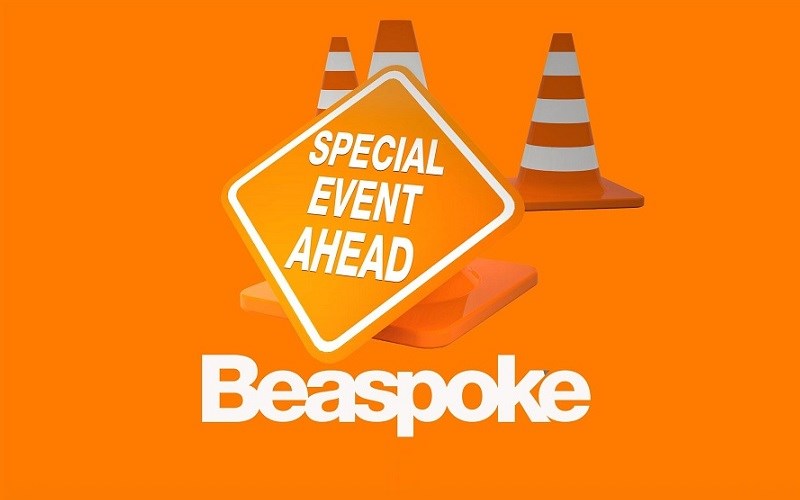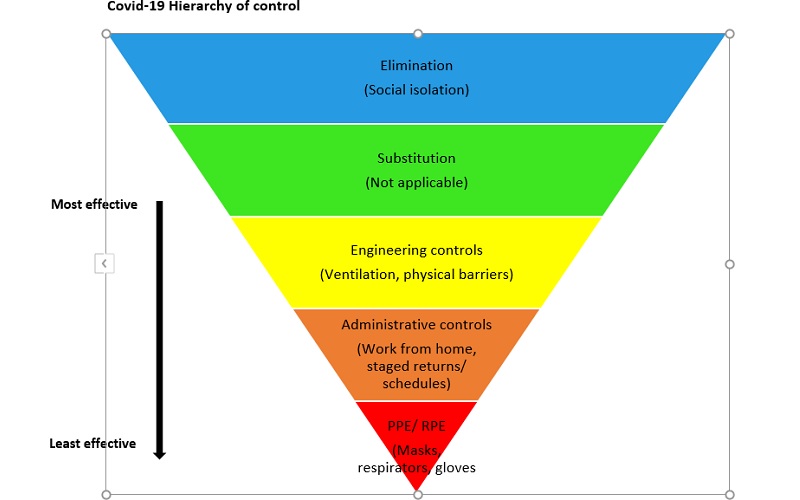
Article by BeaTomlin, Safety and Risk Consultant | Beaspoke
As some are now starting to consider a return to work in the normal physical workplace there is a requirement for all workplaces to complete a risk assessment as part of the permission to resume normal services/operations, so here are some points that may help you navigate this process. But please note, if you can work from home, you must work from home during June.
A Risk Assessment covering exposure to Covid-19 will differ from one place of work to another.
But before the risk assessment is undertaken, the assessor must first ask:
● Who is doing what and how?
● Where they are doing it and
● What are they using?
Understanding the tasks or activities is vital to assess exposure and to quality any subsequent control decisions.
Oh, and who can the assessor be? Well, that be a “competent person” within your team or an external agency.
Risk Assessment Hazard
The risk assessment must recognise the virus as a hazard. It should reflect that the virus is spread in minute water droplets that are expelled from the body through;
● Sneezing
● Coughing
● Talking and breathing
The virus can be transferred to the hands and from there to surfaces. It can survive on surfaces for a period after transfer (depending on such things as the surface type, its moisture content and temperature). The risk assessment should conclude that if it is passed from one person to another, while many survive infection, some may die from the disease. It should be regarded as a high hazard.
Likelihood
Exposure
Consideration must be given to how exposed people are. There is a list of questions to consider, and this is not an exhaustive list, as your workplace may have other factors to consider.
- While in the workplace how might individuals come into contact with people with the disease, how frequently and for how long?
- How do staff travel to work and does this expose them to public crowds?
- Do you know which staff are in the vulnerable groups with underlying medical conditions which makes them more susceptible to the disease? How do you capture this information?
- Do you know which staff have people in their household who may have increased exposure to the disease?
- If someone in a staff member’s household must isolate, what will you require your staff member to do?
- Where staff meet people/contractors/public who may have the disease this increases exposure?
Once these answers to the questions are understood, control to mitigate them can be better considered and implemented.
Control
The safety of hierarchy of control can assist you in considering what can be done. Any mitigating controls devised and implemented must reduce the exposure of employees, contractors, and, members of the public.
Control considerations must include identification of those who may have the disease, preventative measures of what to do and if you, an employee, or member of the public has contracted the disease. In other words, there may-be elements of management systems design to think about. Decisions about what maybe done must be realistic and reasonably practicable: achievable given the resources you have.

Elimination
Elimination is the best form of control. Can we eliminate the virus? Only through vaccination so there is little that can be done by organisations right now. We are reliant on the Governments’ response, however planning now, for any future vaccination programme, so that arrangements can be made promptly for your workplace it recommended.
Physical/Social Distancing and staying at home are not forms of elimination, but an administrative control.
Substitution
Next in descending order is Substitution: Replacing the virus for something less harmful is not possible.
Engineering
Engineering controls are things which place a physical barrier between the person and the hazard or provide mechanical reduction of the hazard.
Exposure
Screens: Placing screens between people (i.e. reception, between desks).
Ventilation: You should contact your HVAC (Heating, Ventilation Air Conditioning) supplier/mechanical engineer for guidelines around specific system recommendations.
Toilets: There is also the possibility for faecal/oral transmission with the virus. Signs should be on place encouraging people to close the lid when flushing the toilet. And everyone must wash their hands for at least 20 seconds and dry well. Employers will need to ensure there is sufficient supply / stock of soap and hand towels etc.
Administrative Controls
Administrative Controls provide the best options for most organisations. The risk assessment must consider how you will keep the workplace and equipment clean, adjust your work practices and ensure people are safe.
Questions and Considerations about designing a safe workplace should include:
- Can you redesign the workplace to maintain social distancing e.g. creating space by rearranging storage etc?
- Can you repurpose rooms to spread staff out?
- Can you reduce space pressure by reducing the number of staff required to work in an area? (e.g. staff who can work remotely from home)
- Identify the places where people find it difficult to avoid one another (entrance/egress points, foyers/reception, security points, lifts, kitchens, toilets resource rooms, hot desks)?
- What measures can you put in place to reduce these busy points. (phased shifts, working team rotations, breaks, closures)?
- Can you provide more hand washing or sterilisation facilities around the workplace?
- Identify the places where most people commonly touch (e.g. doorhandles, control panels, lift buttons, handrails, kettles, coffee machines etc)?
Cleaning
Cleaning is a vital control
1. Consider how you keep commonly touched surfaces sterile and how much more frequently they need to be cleaned?
2. Are you using an effective strength cleaner to kill the virus?
3. Have you amended cleaning checklists to ensure all areas that are needed are being frequently cleaned?
4. Considered the impact on your cleaners or contract cleaners?
5. Cleaners are being sent to places where we believe the virus may have been left on the surface, they have different exposure compared to other employees and public: How will you protect them?
6. As they clean, the viral loading on cloths/ mops will increase, do they have enough to be able to change frequently or the use of disposable cleaning products?
7. Where and how do they dispose of contaminated cloths/waste bins of tissues?
Work Equipment
Question and consideration about work equipment:
1.Can equipment be allocated to an individual rather than shared?
If equipment must be shared, then how will it be cleaned between uses? (e.g. phones, desks, chairs, credit card machines, microphones, 2-way radios, tools etc.)
2.If someone falls ill with Covid-19, what deep cleaning process will be necessary on the equipment they have been using and the areas of the building and / or vehicles they may have been in contact with?
3.What washing/hand sterilising facilities are available to workers and public, how frequently should they wash their hands to reduce potential viral load and spread on equipment and in the environment.
Safe Systems of Work
Question and consideration about Safe Systems of Work:
Can work sequencing be reorganised to avoid employees being in contact with others? When this cannot be avoided, can the time they are in contact be minimised, can they work facing away from one another or can additional safety measures be implemented?
1.What do your staff need to know about the disease and how they might contract it if going to and from work, or from their household?
2.How will you deliver this knowledge?
3.How do you ensure workers know what Covid-19 controls are required in the venue? How will touring and visiting crew be informed?
4.Do the employees know how they can reduce exposure to the virus travelling to and from work?
5.What advice can be provided?
6.What process have you got for staff to report possible infection or exposure, and what do you then require them to do?
7.Advice on Covid-19 is constantly changing, how will you keep current with advice and how will you update your employees?
8.What do your managers need to know to enable them to supervise effectively? How will this be communicated and how will they be held accountable for delivering this requirement?
9.Where freelance staff are used, how will you ensure their compliance in applying Covid-19 controls? (what changes are necessary to your induction programme)?
10.Are employees complying with the new control measures and if not why not?
11.How do you manage people with special needs?
12.What provisions are in your workplace for supporting employees with increased levels of anxiety during this pandemic or who have suffered personal loss as a result?
Personal Protective Equipment (PPE)
1. Personal Protective Equipment (PPE) is the least preferred in the hierarchy of risk control. It is considered the weakest control because it relies on people using it correctly. It introduces many possibilities for error.
2. Consideration include:
If gloves are provided, the virus can still be transferred on the surface. If the wearer then touches their face, they could contract the disease. – Frequent hand washing, good hygiene and cleaning procedures are the preferred option.
3. The wearing of facemasks may reduce the virus being spread to and from others. However, the incorrect use of face masks may increase the risk of exposure. Follow government guidance.
4. Consider the safe disposal of all PPE.
Risk Management
Finding answers to the questions posed will provide a list of possible controls that can be implemented. A risk assessment does NOT control risk. It is the actions of individuals who apply controls that mitigate the risk control action plan making it clear who will do what and by when. The successful delivery of this plan must be monitored, reviewed regularly and updated with new guidance documents when issued by the Government and Worksafe.
Spending effort on developing controls bespoke to your business is a waste of time unless performance is monitored ongoing. Plans need to be in place for routinely reviewing the effectiveness of the controls. It is vital to ensure that these controls are maintained and improved as our knowledge about the virus, it's transmission and its control develops.
I do hope this helps you understand what you need to do and how you can do it as we all start emerging into the big wide world.
Take care, stay safe, and wash your hands!